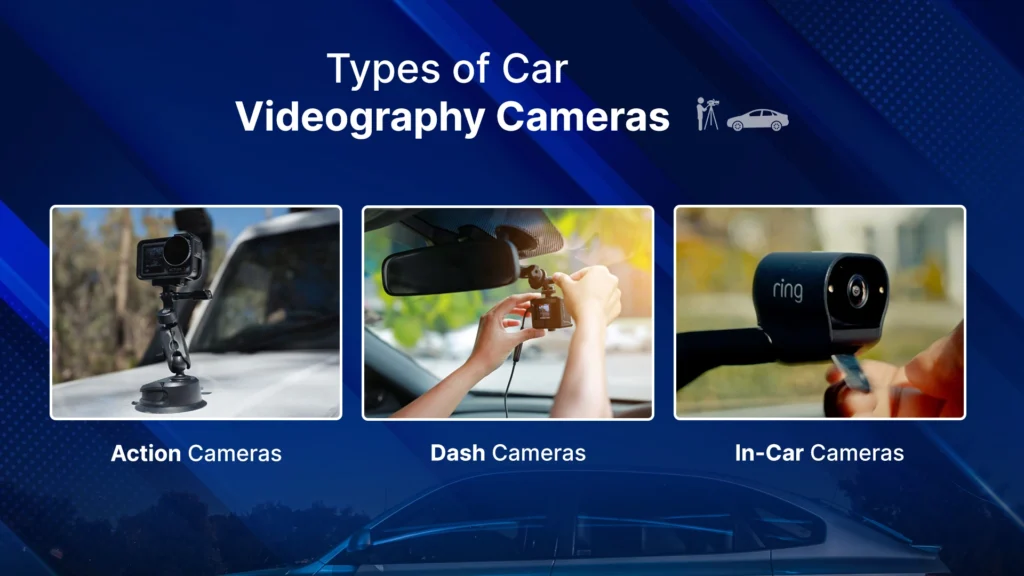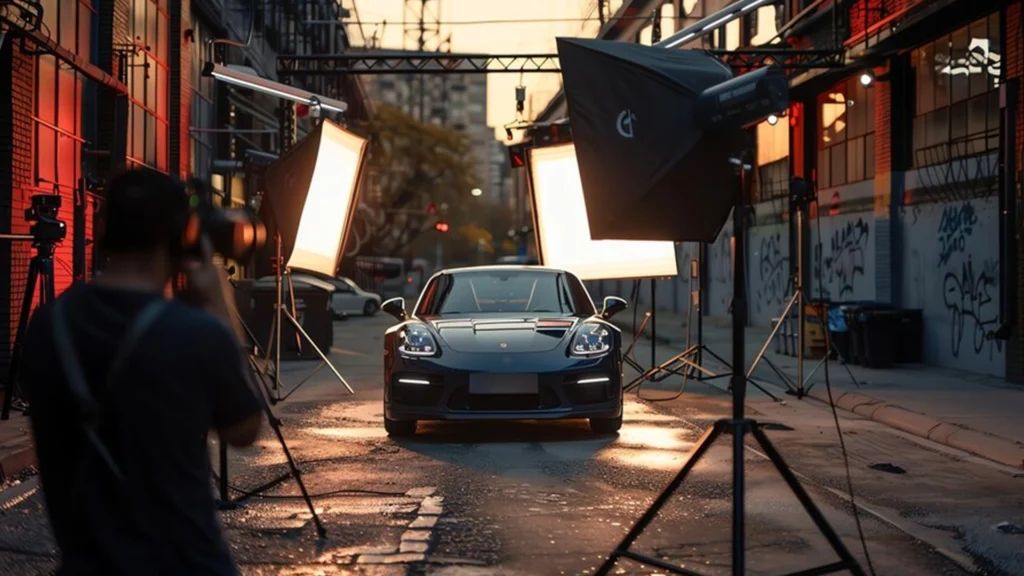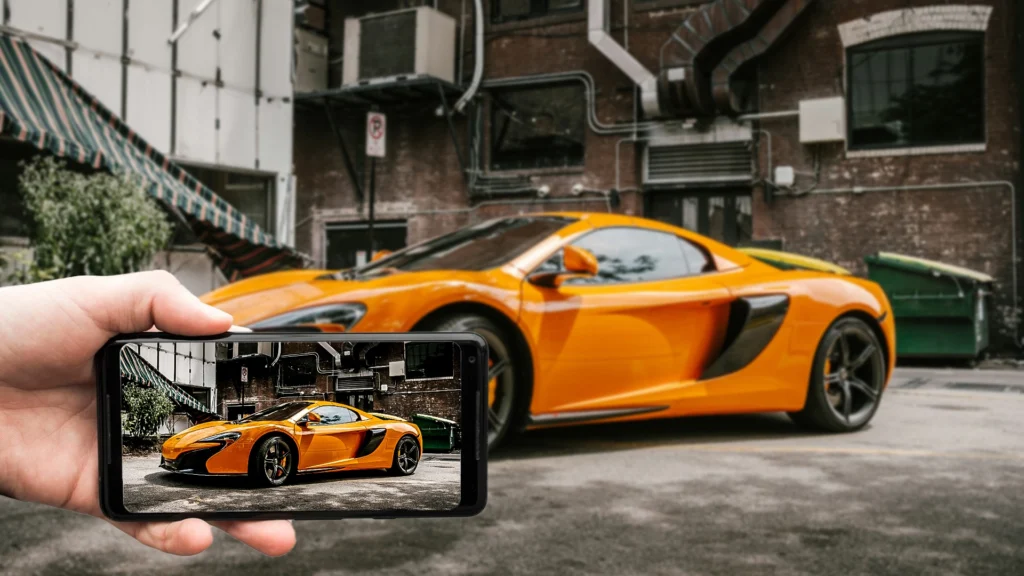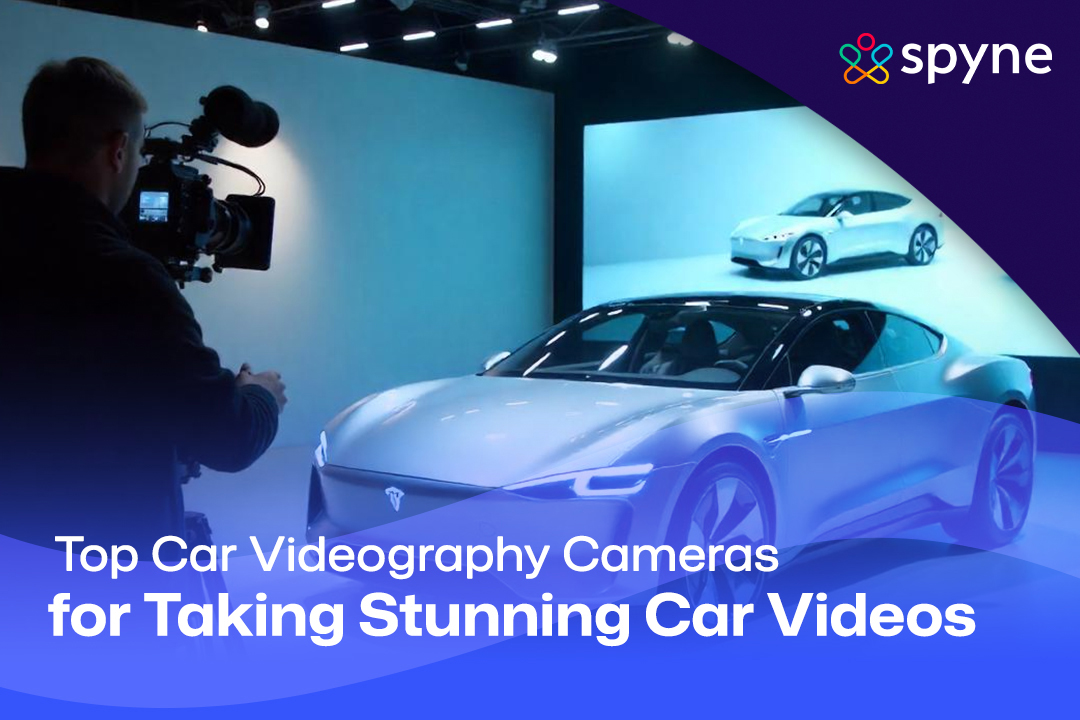If you are a car lover, you might watch a lot of car videos online or might even shoot them yourself. Automotive videography requires a skill set and expertise, but once you get a hold of it, it is a fun experience. But skills and expertise are not the only thing you need for this activity. A good car videography camera is a must in order to shoot some high-quality and engaging content. Not sure which camera to go with? Worry not.
In this blog, we are going to tell you which are the best cameras for car videography and tips that will take your content to the next level!
What is a Car Videography Camera?
A car videography camera is a tool used to record videos of cars for ads, movies, or personal projects. There are different types of video camera for the car available in the market, such as dashcams that capture driving footage, action cameras like GoPros for unique angles, and professional cameras for high-quality shots. There are drones that can be used for aerial views. When choosing a camera, it’s important to look for video quality, stability, and easy mounting options to get the best shots. A good camera improves the quality of used Car Photography.

Best Camera for Car Videography
For clicking high-quality car videos you must require the best video camera for the car. Because it can provide advanced image stabilization, 4K video resolution, and top-end dynamic shot range to enable you to capture breathtaking visuals that offer a cinematic viewing experience.
Here are 3 recommended car cameras that offer some great features that car enthusiasts can use for different needs starting from high-resolution video to advanced autofocus systems. A video camera for the car is the must-have utility while buying your favorite car.
Check out the list of best cameras for automotive videos with their desired features,
Sony A7IV
| Resolution | 33 megapixels |
| Video Capabilities | 4K at 60fps (with a 1.5x crop) |
| Autofocus | An advanced system similar to the Sony A1 |
| Color Science | Improved 10-bit color for better color grading |
| Customization | Highly customizable buttons and menu system |
| Ergonomics | An improved viewfinder, flip-out screen, and robust build |
| Additional Features | No recording limit, photo/video/S&Q mode selector, and three custom memory settings |
Canon EOS R6
| Video Capabilities | 4K with a slight 1.07x crop |
| Recording Limit | 30 minutes |
| Storage | Dual SD card slots (cannot back up videos) |
| Autofocus | Reliable and fast |
| Ergonomics | Good build quality and user-friendly interface |
Lumix S1
| Video Capabilities | 4K at 60fps with a 1.5x crop |
| Autofocus | Not as reliable as competitors |
| Build | Larger body, which might be cumbersome for some users |
| Lens Options | Expensive lenses |
Types of Car Videography Cameras
Car videography cameras serve different purposes in automotive videography, from capturing thrilling action shots to providing security and monitoring capabilities. Here are the types of car videography cameras along with their features:

Action Cameras
Action cameras are lightweight and easy to carry which makes them easy to mount on surfaces. They are sometimes waterproof and shockproof too, which is suitable for high-speed and rugged environments. Their wide-angle lens captures a wide field of view that is perfect for wide driving shots.
Example: GoPro HERO10 Black offers 5.3K video, HyperSmooth stabilization, and various mounting accessories.
Dash Cameras
Dash cameras automatically record when the vehicle is on which provides a constant record of driving. It has features like G-Sensor which automatically saves footage during sudden stops or collisions. Some dashcam for car models record both the front and rear views of the vehicle. Also, many dashcams include GPS functionality to log speed and location data.
Example: 70mai True 2.7K A500S offers 1944P resolution, built-in Wi-Fi, and an optional rear camera.
In-Car Cameras
In-car cameras are designed to capture footage inside the vehicle which is useful for documenting passenger behavior or events. They are often equipped with HD or 4K capabilities for clear footage. These cameras can include multiple cameras to capture different perspectives within the car. Also, some in-car cameras work with other security systems for monitoring.
Example: Minolta MNCD 350X features dual-channel recording with an interior video camera for comprehensive coverage.
Importance of Using the Right Camera
The right camera matters, in terms of technical aspects, creativity, and experience of the videographer. It is very important you use the right car videography camera for your content which can later be used for automotive video marketing. Here’s why:
- Superior Video Quality: A high-decision digicam (4K or better) guarantees sharp, specific, and professional-looking footage, making your content extra attractive.
- Low-Light Performance: Most contemporary cameras are capable of capturing remarkable low-light pictures with excessive ISO performance, so you can shoot clear movies at night or in dim situations.
- Advanced Stabilization: Built-in stabilization and gimbal compatibility assist get rid of shaky photos, making your automobile videos smoother and greatly improves Car cinematography.
- Accelerated Procedures: You can capture and edit footage more quickly with devices that have enhanced focusing, dual filming choices, and high-rate processing, which frees up more time for innovation.
- Various Lens Choices: With adjustable lens frameworks, you may take close-ups of the inside elements as well as incredibly broad shots of the car’s façade.
- High-quality Alternatives: With the advent of 4K capturing, AI-driven autofocus, and sophisticated color correction, several low-cost cameras have made excellent cinematography accessible to anyone.
- Endurance & Climate Resistance: For exterior and thrilling car scenes, sturdy cameras have climate-protected frames offering dependability under harsh circumstances.
- Smooth Post-production Operation: Editing is made simple by video of excellent quality that has more color dimension and a wider dynamic spectrum, which lessens the necessity for lengthy post-production fixes.
- Intuitive Highlights: Nowadays, cameras are more productive and easy for video makers of any level of expertise due to touchscreen monitors, adjustable preferences, and AI-enhanced autofocus. It enhances your narrative with an overall impact while giving you the true spirit of automobile video production, regardless of whether it is the velocity, layout, or feelings associated with the car.
Best Camera for Filming Cars: Enhance Your Automotive Shoots
The most important features of such a camera would be high resolution, fast focus, great stabilization, and light adaptability. To be able to seize highly sharp car videos, one needs the best camera for filming cars – be that for shooting high-speed action shots, recording cinematic automotive commercials, or setting up automobile vlogs. With this, here are the best cameras for car content in 2024:
1. Sony FX3 Cinematic Camera
The Sony FX3 is a compact, full-frame cinema camera designed for the filmmaker who demands the best video quality in a light and unobtrusive body possible.
- 4K resolution video @ 120 frames per second
- Autofocus: Superior AI-driven autofocus with continuous monitoring.
- Stabilization: Handheld photography with IBIS in-body picture stabilization
- Outstanding low-light performance: Commendable with two native ISOs and more than 15 dynamic range pauses.
- Best For: Top-notch, spectacular car photography.
2. Canon EOS Series R5 HR Camera
The Canon EOS R5 is an excellent choice when you need to shoot ultra-detailed videography.
- Resolution of the Video: 4K resolution @ 120 frames per second, 8K resolution at 30 frames per second
- Autofocus: Dual Pixel AF II with object detection
- Stability: 5-axis IBIS for stabilization
- Low-Light Efficiency: Outstanding performance when setting the ISO with minimal vibration
- Best For: Expensive commercial vehicle filmmaking.
3. GoPro HERO12 Black Action Camera
For capturing interior or exterior dynamic shots on a moving vehicle, the GoPro HERO12 Black must be a top priority to choose from.
- Videos: 4K resolution @ 120 frames per second, 5.3K resolution @ 60 frames per second
- Stability: For seamless video, employ the HyperSmooth 6.0 version.
- Adaptability: Suitable for different vehicle mounting.
- Effectiveness: Prepared to withstand harsh environments, have water resistance, and be shockproof.
- Ideal For: Rough terrain excursions, rapid connectivity driving video & point-of-view pictures.
4. DJI Osmo Action 4 Camera
For content creators looking for a reliable action camera at a more affordable price, the DJI Osmo Action 4 is a fantastic pick.
- Resolution: 4K resolution video @ 120 frames per second
- Stability: HorizonSteady & RockSteady technologies
- Low-Light Efficiency: Superior night filming with an expanded-size of sensor
- Ideal For: In-car viewpoints, racing & automobile vlogging
5. Blackmagic Pocket Cinema Camera 6K Pro
The Blackmagic Pocket Cinema Camera 6K Pro delivers excellent color depth and dynamic range, which is suitable for professional car shoots.
- Videos: 50 frames per second at 6K resolution
- Grade color: With 13 dynamic stoppages using Blackmagic RAW
- Lens Alternatives: Allows for artistic versatility with Canon EF-mount optics
- Ideal For: Dramatic narrative and high-end automobile cinematography
Some of the honorable mentions,
- Sony A7S III – Excellent for low-light and slow-motion car footage
- Fujifilm X-H2S – Great for hybrid shooters who need photos and videos
- Panasonic GH6 – A solid Micro Four Thirds camera with 5.7K recording
What Features Does a Camera for Car Videography Need?
When selecting an automotive videography camera, it is important to ensure there are features for high-quality footage and ease of use. Here are some more features a camera for car videography needs:
1) High resolution to capture a car’s details and features with clarity.
2) Wide dynamic range for more flexibility in editing.
3) Fast autofocus system for capturing moving cars.
4) High ISO performance for clear images in low light.
5) Image stabilization to avoid blurry images when shooting from another moving vehicle.
6) High burst rate for capturing cars in motion.
7) Weather covering or sealing for outdoor car shoots in changing weather.
8) 4K video for creating high-definition car videos easily.
Tips for Car Videography
You may improve the standard of your automobile movies with the good camera for car videos and procedures, producing aesthetically stunning content. It’s ideal for social networking sites, personal endeavors & automotive video advertising. Check out the below pointers for recent professional advice regarding how to acquire the greatest vehicle photography in 2024:
1. Employ a Tripod or Camera Stabilizer
Soft and steady filming is essential for automobile films that seem expert. Investing in a stabilizer or tripod helps to avoid wobbly photos, particularly while shooting cars that move. Let us consider,
- DJI RS 3 Pro for mirrorless or cinema cameras
- Zhiyun Crane 4 for heavy camera rigs
- DJI OM 6 for smartphone videography
For car-mounted shots, use suction cup mounts like the SmallRig Suction Cup Mount Kit for a stable, dynamic perspective.
2. Get Highly Skilled in Different Shot Variations
Change the arrangement of shots to continue making the footage captivating:
- Expansive shots: Set the environment and document the surroundings of the vehicle.
- Detail shots: Highlight aesthetic components like wheels, emblems & headlamps.
- Using tracking shots, you may record the vehicle moving for use in motion pictures.
- Interior Shots: Give attention to the dashboard materials, entertainment displays & seat comfort.
Slow-motion video (120 frames per second or more in 4K resolution) may highlight mobility and create suspense.
3. Record High-Quality Engine and Road Sounds
Audio completes the atmosphere of car videos. Recordings:
Engine roaring and exhaust sounds with the help of an external microphone, RØDE VideoMic Pro+, or Zoom H5 Recorder.
- Tire sounds on various surfaces to create realism.
- Environmental sounds give a rich cinematic feel.
- Synchronize high-quality audio with B-roll footage to get professional output.
4. Plan Your Frames & Storyboard
Well-pre-planning leads to streamlining your shoot and makes sure you get the best shots. Consider:
- The sun has just risen or is about to set, creating natural cinematic lighting (Golden Hour).
- Locations that suit the personality of the car like city for sports cars & mountains for SUVs).
- Shot list & transitions to keep the video lively.
- Apps ShotDeck or Sun Surveyor for shot planning and lighting estimation.

5. Camera Parameters to Get the Best Picture
Mount your recording gear as follows to get the finest potential video footage:
- Shutter Speed: 1/50s @ 24 frames per second & 1/120s @ 60 frames per second are the two extremes of the 180° shutter rate guideline.
- Focus area length: Implement depth of focus and wide apertures (f/2.8 or lower) for creative images.
- ISO: To cancel the sound from the surrounding environment, configure the ISO to the lowest possible level of 100 to 400 range.
- Color Profiling: Employ RAW or LOG for added flexibility during post-production.
Bonus Hint: Try using ND lenses to eliminate lighting while shooting in bright natural settings.
6. Pick Intriguing Unusual Venues to Record Footage
Take videos in different locations to promote the adaptability of your vehicle:
- Urban settings – Skyscrapers, tunnels, and neon lights add drama.
- Coastal roads – Perfect for scenic drives and sunset reflections.
- Off-road terrains – Focus on SUVs and rugged vehicle capability.
- Race tracks – Best suited for performance cars, with tracking and panning shots.
For instance, subtle variation in the background adds drama and storytelling interest.
7. Drone Shots – Aerial
Drones will add cinematic flair to car videos with high-speed tracking shots and sweeping landscape views. Top recommendations:
- DJI Air 3 – Good starting point, 4K at 100fps, dual camera.
- DJI Inspire 3 – Pro-grade, recording at 8K, and fast-tracking.
- Autel EVO Lite+ – Excellent low-light performance.
Pro Tip: Use ActiveTrack or Follow Me mode for seamless car-tracking shots.
In-Car Video Camera: Top Picks for Interior Footage
Achieving good quality interior car video recordings would require an advanced camera with stabilization features, low-light sensitivity, and resolution. Whether you are creating vlogs, automotive reviews, or commercial content, here are the best in-car video cameras for 2024 based on the latest trends and innovations.
1. GoPro Hero 12 Black – Best Action Camera for Car Interiors
Key Features:
- 5.3K at 60fps & 4K at 120fps for sharp, cinematic shots
- HyperSmooth 6.0 stabilization- shake-free
- HDR video & enhanced low-light
- Voice control & hands-free
- Ruggedly compact, tough & easy to mount, great for dynamic in-car shots and first-person perspectives.
2. The Best Lightweight Camera for Vlogging: DJI Osmo Pocket 3
Key Features:
- One-inch CMOS sensor with 10-bit D-Log M color pattern & higher resolution for dim lighting, 4K resolution @ 120 frames per second
- 3-axis tripod stabilization
- Auto-object monitoring using ActiveTrack 6.0
- Commendable for vloggers who want high-quality, inside shots of the cars without spending on additional equipment.
3. The Greatest 360° Camera for Panoramic Photos: Insta360 X3
Key Features:
- 5.7K 360° video recording for unique, interactive footage
- FlowState stabilization for buttery-smooth shots
- AI-powered reframing lets you adjust angles in post-production
- Waterproof & rugged design
- Capturing all angles and editing the perfect shot later making for great car reviews, creative storytelling, etc.
4. Top Priority Mirrorless Camera for Commercial Photographers: Sony ZV-E1
Key Features:
- Full frame sensor, with 4K at 120fps
- AI-powered autofocus w/real-time subject tracking
- Industry-leading low-light performance
- Compact body w/incrementally interchangeable lenses
- This mirrorless camera offers remarkable information, dynamic flexibility, and focusing precision for inside shots that are fit for a movie.
5. Blackmagic Pocket Film Camera 6K Pro: The Greatest for Expensive Filmmaking
Key Features:
- Super 35 sensor with 6K RAW recording
- Built-in ND filters for outdoor and bright environments
- Dual native ISO for excellent low-light performance
- Professional audio inputs for high-quality sound recording
- Perfect for commercial automotive videography, so you get that Hollywood-quality footage inside the car.
Key Things to Look for in In-Car Videography Camera

- Resolution & Frame Rate – Opt for 4K resolution @ 60 frames per second or more for pro-level quality.
- Stabilization – Best camera for car videos consisting of EIS, IBIS, or even built-in tripods can assist you in shooting silky-smooth footage.
- Low-Light Performance – Full-frame sensors & HDR help bring out details in low-light settings.
- Audio Quality – This includes excellent external microphone support with high-quality dialogue & engine sounds.
- Mounting & Durability – The in-car configuration has a compact design with heat-resistant components & easy mounting solutions are preferred.
What to Consider When Purchasing a Camera for Car Videography?
When buying a car videography camera, it’s important to choose one that meets your specific needs and helps you capture high-quality footage. Here are some key factors to keep in mind:
1) Resolution and Frame Rate
Aim for a best camera for car content that offers at least 4K resolution at 60fps. This ensures you get detailed, smooth footage, which is essential for capturing fast-moving cars and creating slow-motion shots.
2) Autofocus
A fast and reliable autofocus system is crucial. It helps track moving vehicles and keeps the footage sharp, especially during action-packed scenes.
3) Stabilization
Look for cameras with built-in stabilization or plan on using external gimbals. This feature reduces camera shake, ensuring your footage remains smooth, even when shooting from a moving car.
4) Lens Options
The best camera for car videos with interchangeable lenses gives you flexibility. Wide-angle lenses are great for capturing the whole car and its surroundings, while telephoto and macro lenses let you focus on specific details.
5) Durability and Portability
Consider the camera’s build quality and size. A rugged, compact camera is ideal for mounting on vehicles and handling various shooting conditions.
6) Audio Capabilities
High-quality audio can elevate your videos. If you want to capture engine sounds or ambient noise, consider a good camera for car videos that supports external microphones for better sound.
7) Additional Features
Features like night vision, loop recording, and GPS tracking can add extra functionality, especially if you’re using the camera as a dashcam for car. These can make your videography more versatile and convenient.
How Can You Take Good Videos of Your Car with a Phone?
You don’t need a pricey camera to make professional-looking car videos. With high-powered cameras and stabilization and AI-enhanced features in most modern smartphones, these are perfect for shooting car dealership videos, social media content, or personal automotive shoots. Follow the expert tips on how to shoot properly using the best camera for automotive videos by your phone.
1. Clean Your Camera Lens for Crystal-Clear Shots
You need to clean the camera lens on your phone using a microfiber cloth before hitting the record. All that dust and smudges or fingerprints would reduce the sharpness and clarity of your video.
2. Setting Up the Best Camera for Car Content
- Resolution: Set it to 4K at 30fps or 60fps for crisp and professional-quality video.
- Frame Rate: Use 60fps to get smooth actions and 24fps for the cinematic look.
- HDR Mode: If supported, turn on HDR video to record more detail in bright and dark areas.
3. Stabilize Your Footage for a Professional Look
- Shaky videos look unprofessional. Use these methods to keep your shots steady:
- Built-in Stabilization: Most smartphones have EIS (Electronic Image Stabilization)—turn it on!
- Handheld Stabilization: Hold your phone with both hands and move slowly and smoothly.
- Gimbal or Tripod: Investing in a smartphone gimbal (like the DJI OM 6) or a tripod with a phone mount will greatly enhance video quality.
4. Shoot in the Best Lighting
- Magical Golden Hour: Film during sunrise or sunset to create a soft, golden glow.
- Avoid Harsh Midday Sun: If shooting during the day, try to park in a partially shaded location to minimize glare.
- Night Mode or a good low-light camera phone, such as the iPhone 15 Pro or Samsung Galaxy S24 Ultra.
5. Unconventional Angles
- Low Angles: Your car will look powerful and aggressive.
- High Angles (Drone or Overhead Shots): The whole scene and surroundings will be shown.
- Close-ups: Details like headlights, rims, or interiors.
- Tracking Shots: Walk alongside the car for dynamic motion shots.
6. Do Not Use Digital Zoom—Move Closer Instead
Digital zoom degrades the image quality. Instead, physically move closer or use a smartphone lens attachment like a Moment Wide Lens for a better result.
7. Good Audio Quality
Good audio will make your car videos better.
Here’s how to record good sound:
- External Microphone
- A Clip-on lapel mic or shotgun mic is used to enhance voiceovers and car engine sounds.
- Quiet Location
- Reduce the background noise to get cleaner audio.
- Use an App: Apps like Dolby On or Filmic Pro help capture high-fidelity sound.
8. Enhance Your Video with Editing Apps
After recording, fine-tune your footage with mobile editing apps:
- CapCut / VN Video Editor – Easy to use, with cinematic filters and effects.
- Adobe Premiere Rush – Perfect for color correction and transitions.
- LumaFusion (iOS) / Kinemaster (Android & iOS) – Advanced video editing for professionals.
Conclusion
Choosing a good camera for car videos is very important for creating top-notch car videos that stand out. With the tips and recommended car camera we have shared, you’ll be well-equipped to capture high-quality footage that truly presents your car. Whether you’re just starting out or looking to improve your skills, investing in the right gear will make a big difference in the quality of your videos. Also, check out Spyne for more guides on videography and editing. Happy filming!



















